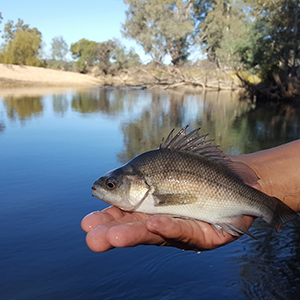Larval fish sensitivity to a simulated cold-water pulse varies between species and age

Accepted: 27 June 2022
Supplementary: 161
HTML: 135
All claims expressed in this article are solely those of the authors and do not necessarily represent those of their affiliated organizations, or those of the publisher, the editors and the reviewers. Any product that may be evaluated in this article or claim that may be made by its manufacturer is not guaranteed or endorsed by the publisher.
Authors
The release of cold-water from hypolimnetic zones of impoundments sharply reduces downstream riverine water temperature. This cold-water pollution (CWP) can extend for hundreds of kilometres, severely challenging the physiological ability of aquatic fauna, particularly ectotherms such as fish, to maintain essential processes such as metabolism, development and growth and survival. The impact of CWP on native fish, especially early life stages, is poorly known. We investigated the effect of a 24-hour exposure to a range of environmentally-related water temperatures (8, 10, 12, 14, 16, 18 and 20°C) on three age-classes (<24-hour-old, 7-day and 14-day-old larvae) of two Australian native fish species: Murray cod (Maccullochella peelii) and Macquarie perch (Macquaria australasica). Overall, larvae of M. peelii were more sensitive to lower water temperatures and hence CWP than M. australasica, indicated by higher rates of equilibrium loss. Larvae of M. peelii were most sensitive to exposure at seven days old whereas M. australasica larvae were most sensitive at <24-h-old. Using our results, we modelled pre- and post-impoundment temperature scenarios and estimated the downstream CWP footprint for both species in an Australian river reach. Larvae of M. peelii were predicted to be absent from the first 26 km of river downstream of the impoundment compared with no impact on the distribution of M. australasica. Managing riverine water temperature below impoundments is fundamental to promoting positive outcomes for endemic fish on not only a local, but global basis. This study emphasises the differential impact of CWP among the critical early life stages and fish species and highlights the urgent need to better manage hypolimnetic water releases to improve downstream river ecosystems.
Edited by
Pietro Volta, CNR-IRSA Verbania, ItalyHow to Cite

This work is licensed under a Creative Commons Attribution-NonCommercial 4.0 International License.
Similar Articles
- Fabien Bourinet, Orlane Anneville, Hilaire Drouineau, Chloé Goulon, Jean Guillard, Alexandre Richard, Synchrony in whitefish stock dynamics: disentangling the effects of local drivers and climate , Journal of Limnology: Vol. 82 (2023)
- Daniela Ghia, Gianluca Fea, Fabio Ercoli, Roberto Sacchi, Escape rooms: behavioural response of two invasive crayfish species under water decline scenarios , Journal of Limnology: Vol. 83 (2024)
- Leticia Miguel-Chinchilla, Dani Boix, Stephanie Gascón, Francisco A. Comín, Macroinvertebrate biodiversity patterns during primary succession in manmade ponds in north-eastern Spain , Journal of Limnology: Vol. 73 No. 3 (2014)
- Selene Babini, Luciana Cibils Martina, Elisa Luque, Noemi Gari, Nancy Salas, Adolfo L. Martino, Anuran larvae diet from agroecosystem’s ponds: environmental quality and implications for their populations , Journal of Limnology: Vol. 76 No. 1 (2017)
- Anna Cichy, Maria Urbańska, Anna Marszewska, Wojciech Andrzejewski, Elżbieta Żbikowska, The invasive Chinese pond mussel Sinanodonta woodiana (Lea, 1834) as a host for native symbionts in European waters , Journal of Limnology: Vol. 75 No. 2 (2016)
- Bartosz Czernecki, Mariusz Ptak, The impact of global warming on lake surface water temperature in Poland - the application of empirical-statistical downscaling, 1971-2100 , Journal of Limnology: Vol. 77 No. 2 (2018)
- Cecilia Laprida, Maria S. Plastani, Alicia Irurzún, Claudia Gogorza, Ana M. Navas, Blas Valero-Garcés, Ana M. Sinito, Mid-late Holocene lake levels and trophic states of a shallow lake from the southern Pampa plain, Argentina , Journal of Limnology: Vol. 73 No. 2 (2014)
- Renan S. Rezende, Patrícia R.S. Correia, José F. Gonçalves Jr, Anderson M. Santos, Organic matter dynamics in a savanna transition riparian zone: Input of plant reproductive parts increases leaf breakdown process , Journal of Limnology: Vol. 76 No. 3 (2017)
- Robert Sturm, Modelling ecological specificities of freshwater molluscs: the exemplary case of Bythinella austriaca (v. Frauenfeld, 1857) (Gastropoda, Prosobranchia) , Journal of Limnology: Vol. 75 No. 3 (2016)
- Mariano Bresciani, Rossano Bolpagni, Federica Braga, Alessandro Oggioni, Claudia Giardino, Retrospective assessment of macrophytic communities in southern Lake Garda (Italy) from in situ and MIVIS (Multispectral Infrared and Visible Imaging Spectrometer) data , Journal of Limnology: Vol. 71 No. 1 (2012)
<< < 15 16 17 18 19 20 21 22 23 24 > >>
You may also start an advanced similarity search for this article.
-
John D. Koehn, Charles R. Todd, Henry Wootton, Michael JoyMarine and Freshwater Research : 2023

 https://doi.org/10.4081/jlimnol.2022.2056
https://doi.org/10.4081/jlimnol.2022.2056





